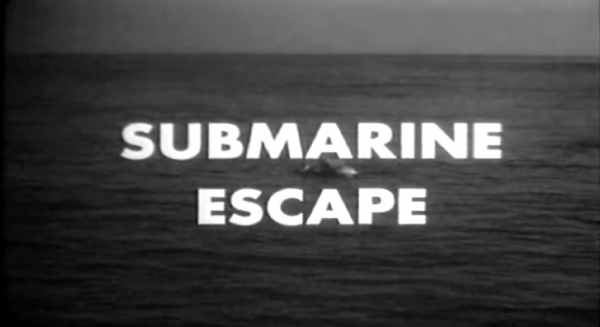And this 1953 United States Navy training film describes two ways to do so: collective escape via rescue chamber, and individual escape using SEAs.
The film first follows a fellow named [Baxter] and his men in the aft torpedo room. His sub has failed to surface as scheduled. There are no officers present at the time of distress, so [Baxter, Torpedoman First] is in charge. His first directive is that [Johnson] extinguish his Chesterfield. There’ll be time enough for smoking on the rescue ship, [Johnson].
[Baxter] releases a marker buoy because it is daytime and the weather is fair. Had other conditions prevailed, [Baxter] would send up flares and bang on the hull to provide a sonic beacon for rescuers. Next, he checks the forward compartments. If they are clear, he leaves the hatches open to give his men more air. He checks the air purity and engages [Brooklyn] to pull down some CO2 absorbent.
[Baxter] and his men will be okay for a while. They have plenty of drinking water, food, juice, supplemental oxygen, and CO2 absorbent. Their best move is to take it easy and wait for the rescue chamber. That way, they’ll avoid drowning, exposure, and CO2 poisoning.
Elsewhere in the forward torpedo chamber, there’s a chlorine leak and it can’t be stopped. These nameless sailors have to work quickly to escape the noxious gas. First, they pass around the SEAs and turn them into respirators. Soda lime will filter out the chlorine gas from their lungs and eyes. They too will release a marker buoy, but the first order of business is to move to the escape trunk.
Communicating through gestures, the lead man assigns three men to break out the life raft. The men move to the trunk with the buoy, raft, ascending line, and a divers’ knife. They also take a battle lantern, hand tools, and spare SEAs, but leave their shoes behind. After equalizing the pressure in the trunk, they can get going on their escape. They open the hatch, float the buoy, and tie it off. Now the raft can be floated up the buoy line. Since they are 100 feet down, they send a man every ten seconds up the buoy line and he is to move approximately one foot per second. First man to surface inflates the raft, and Bob’s your uncle. Now, they just have to prevent sunburn and tell stories until the rescue ship finds them.
Continue reading “Retrotechtacular: There’s More Than One Way To Escape A Submarine”












